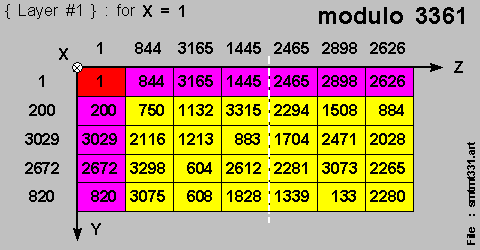In the Section , we shall construct a { Multiplication Table } for [ modulo 3361 ] ,
but with a new 'twist' identified here .
The positions of { multiplicative conjugate pairs } are also identified .
For the { prime number } [ P ] being equal to [ 3,361 ] , we set up the corresponding value [ Q ] such that :
And we can write :
We can then set-up the { core elements } for building the { Multiplication Table } for [ modulo 3361 ] , as follows :



but excluding the solution-value [ 1 ] .
as per the diagram on-the-left , below .



but excluding the solution-value [ 1 ] .
as per the diagram on-the-right , above .

but excluding the solution-value [ 1 ] ;
But there is a new 'twist' here :



( This phenomenon of splitting the 'quasi' { RING OF 6 } into 2 x { RING's OF 3 } ] will be further studied in the next Section , on { FIRON - 2/P } . )
Let us now take a quick look at the positions of { multiplicative conjugates } on these { core elements } ,
And we bring-in , firstly , the { Characteristic Pyramid } from above :

But we shall now concentrate on the section to-the-right of the { white-color dotted-line } , as marked above ,

Let us now bring-in the { RING OF 2 } , as per the diagram on-the-left , below :


Let us also bring-in the { RING OF 4 } , as per the diagram on-the-right , above :
And finally , we bring-in the 'quasi' { RING OF 6 } :

Clearly , { multiplicative conjugate pairs } can be readily & easily identified on the { core elements } , based on their positions in each of the structures ;
We then have this 3-Dimension [ 3 x 5 x 7 ] { Multiplication Table } for [ modulo 3361 ] with :
and we have this { 3-layers presentation } of the { Multiplication Table } as follows :



{ 2465 - 2898 - 2626 } [ modulo 3361 ] being another set of closed-loop { squaring relations } ;
so that { crossing-over the white-color dotted-line } is not allowed .
Let us now take a look at each of the differently-colored area in the { Multiplication Table } above :
Let us now take a look at the 4 x { RING's OF 12 } for the 48 elements in the { light-green-color area } :




And we also note here that :
so that each of the 2 { multiplicative conjugate pairs } indicated above are also on { separate RING's } .
But let us also understand why there are 4 x { RING's OF 12 } here .
This is because :
so that there are now [ 2 x 2 ] or 4 x { RING's OF 12 } .
We have , in this Section , constructed a { Multiplication Table } of { 105 elements } for [ modulo 3361 ] , using the { core elements } :
And we simply note here that :
so that the full field of [ 32 x 105 ] or { 3360 elements } has now been fully characterized .
And we are now ready to move-on to next Section , on why the size of the { RING's } are controlled by { FIRON - 2/P } .